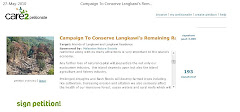Dry season here means open burning!?
Hey Langkawians! Did anyone of you spot this?
I did. With my guests. We were on the coast by boat at 3pm yesterday and I spotted this smoke coming from Kilim area.
Burning of land to clear for development? or for agriculture? Someone chucked a cigarette butt over dried vegetation?
Whatever the reasons, this sighting is disturbing not only to me and also to my guests aka tourists...
... Read full post ...
Pasir Ris west still alive
1 day ago





































